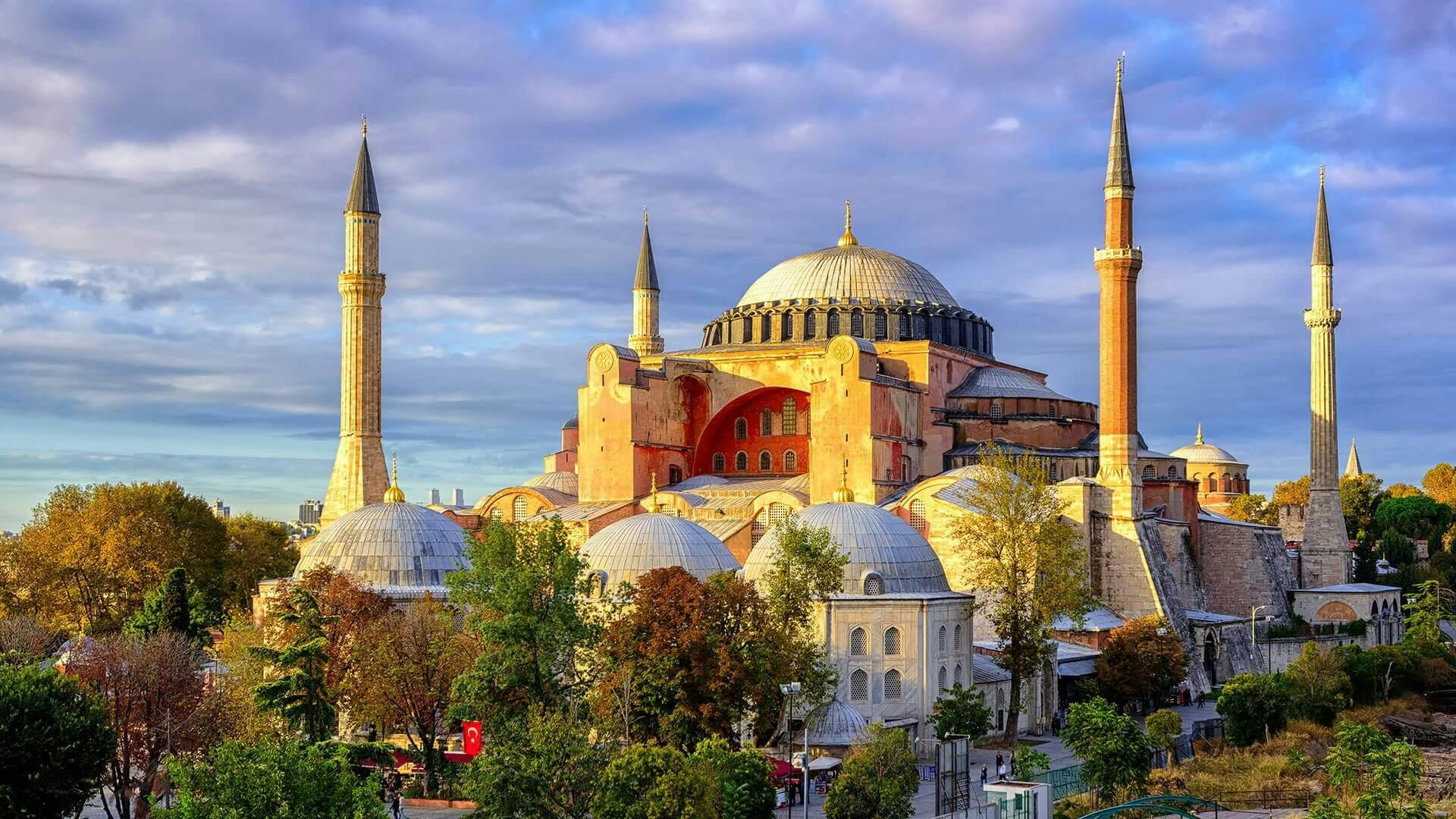The Hagia Sophia: 16 Centuries Of History And Influence

Table of Contents
The Byzantine Era: Birth of a Masterpiece (6th Century CE)
The Hagia Sophia, originally conceived as a church, embodies the pinnacle of Byzantine architecture. Emperor Justinian I, commissioning its construction in the 6th century CE, aimed to create a structure that would surpass all others in size, grandeur, and beauty. This architectural marvel showcases groundbreaking techniques for its time, pushing the boundaries of engineering and design.
- Innovative Building Techniques: The Hagia Sophia's massive dome, a feat of engineering for its era, was achieved through the use of pendentives, ingenious architectural elements that transitioned the weight of the dome to the four supporting piers. This innovation allowed for a larger, more soaring dome than previously possible.
- Imposing Size and Grandeur: Its sheer scale and majestic proportions were unprecedented. The Hagia Sophia's vast interior space, filled with light from numerous windows, created an awe-inspiring atmosphere, reinforcing its status as the center of the Byzantine Empire.
- Religious and Political Heart: The Hagia Sophia served as the heart of the Byzantine Empire, not merely as a place of worship but as a focal point for religious ceremonies, political gatherings, and imperial power. Its location in Constantinople underscored its importance as the capital of the Eastern Roman Empire.
- Stunning Mosaics: The interior was adorned with exquisite mosaics, vibrant depictions of religious figures and scenes that represented the height of Byzantine artistic achievement. These mosaics, many of which have survived to this day, offer a priceless glimpse into the artistic and spiritual world of the Byzantine era.
Ottoman Transformation: Mosque and Symbol of Power (1453-1931)
The conquest of Constantinople by Sultan Mehmet II in 1453 marked a turning point in the Hagia Sophia's history. Converted into a mosque, it became a powerful symbol of Ottoman dominance and Islamic faith. This transformation, however, did not erase the Byzantine legacy but rather layered a new cultural significance onto the existing structure.
- Addition of Minarets: Four majestic minarets were added to the exterior, signifying its new function as a mosque. These slender towers, calling Muslims to prayer, became iconic features of the Hagia Sophia's silhouette against the Istanbul skyline.
- Cultural Landscape Shift: The conversion reflected a significant shift in the cultural landscape of Constantinople, now Istanbul, marking the transition from a predominantly Christian city to one under Muslim rule.
- Preservation and Adaptation: The Ottomans skillfully adapted the existing Byzantine structure, preserving much of its architectural integrity while integrating Islamic elements. This testament to architectural coexistence demonstrates a unique approach to cultural integration.
- Symbol of Ottoman Power: The Hagia Sophia served as a symbol of Ottoman power and religious devotion, reflecting the empire's grandeur and the centrality of Islam in its culture.
- Islamic Artistic Additions: Beautiful calligraphy, intricate tilework, and other Islamic artistic elements were added throughout the interior, enriching the Hagia Sophia's already stunning aesthetic while maintaining a sense of harmony with the Byzantine heritage.
Modern Hagia Sophia: Museum and Monument (1935-Present)
In 1935, under the leadership of Mustafa Kemal Atatürk, the Hagia Sophia was secularized and transformed into a museum. This decision reflected the modernizing vision of the newly formed Turkish Republic, aiming to establish a secular state separate from religious authority.
- Secularization's Significance: The secularization of the Hagia Sophia was a pivotal moment in shaping modern Turkey's identity, representing a shift away from a theocratic state towards a more secular governance.
- Ongoing Conservation and Restoration: Since its conversion into a museum, extensive conservation and restoration efforts have been undertaken to preserve the Hagia Sophia's architectural and artistic treasures for future generations.
- Major Tourist Attraction: Today, the Hagia Sophia is one of Turkey's most popular tourist attractions, drawing millions of visitors annually. Its economic impact on Istanbul is substantial, boosting tourism and local businesses.
- UNESCO World Heritage Site: Recognizing its outstanding universal value, UNESCO designated the Hagia Sophia a World Heritage Site, underscoring its importance to global cultural heritage.
- Recent Controversies: Recent debates and controversies surrounding the Hagia Sophia's status highlight the ongoing tension between its historical religious significance and its current role as a secular museum, a reminder of its complex and layered history.
The Enduring Legacy of the Hagia Sophia: Architectural and Cultural Influence
The Hagia Sophia's enduring legacy extends far beyond its physical presence. Its architectural innovations and design have profoundly influenced subsequent buildings across various cultures and time periods. Its cultural impact continues to resonate in art, literature, and the global imagination.
- Architectural Influence: The Hagia Sophia's innovative dome design and spatial organization have inspired countless architects and engineers throughout history, impacting both Islamic and Western architectural styles.
- Global Representation: The Hagia Sophia's image is ubiquitous, appearing in art, literature, film, and photography. Its iconic dome and silhouette have become globally recognized symbols of Istanbul and a powerful visual representation of cultural exchange.
- Symbol of Cultural Bridges: The Hagia Sophia serves as a potent symbol of the convergence and interaction of different cultures and religions, representing a historical space where Byzantine, Ottoman, and modern Turkish identities intertwine.
- Source of Inspiration: To this day, the Hagia Sophia serves as an enduring source of inspiration for architects, artists, and scholars, its story continuing to unfold across generations.
Conclusion:
From its Byzantine origins as a magnificent basilica to its role as a revered Ottoman mosque and its current status as a museum, the Hagia Sophia stands as a remarkable testament to architectural brilliance and the enduring power of history. Understanding its evolution across 16 centuries offers a profound insight into the cultural and religious transformations that have shaped the world. Dive deeper into the fascinating history of the Hagia Sophia and discover its enduring legacy for yourself! Explore its architectural wonders and learn more about this iconic structure – the Hagia Sophia awaits.

Featured Posts
-
 North Koreas Ukraine Involvement Troop Deployment Confirmed
Apr 29, 2025
North Koreas Ukraine Involvement Troop Deployment Confirmed
Apr 29, 2025 -
 Debunking Ai Intelligence Exploring The Gaps In Current Ai Capabilities
Apr 29, 2025
Debunking Ai Intelligence Exploring The Gaps In Current Ai Capabilities
Apr 29, 2025 -
 The Hagia Sophia 16 Centuries Of History And Influence
Apr 29, 2025
The Hagia Sophia 16 Centuries Of History And Influence
Apr 29, 2025 -
 Revealed Xs Post Debt Sale Financials And Company Restructuring
Apr 29, 2025
Revealed Xs Post Debt Sale Financials And Company Restructuring
Apr 29, 2025 -
 Oh What A Beautiful World Willie Nelsons Latest Album Details
Apr 29, 2025
Oh What A Beautiful World Willie Nelsons Latest Album Details
Apr 29, 2025
Latest Posts
-
 Trumps Potential Pardon Of Pete Rose A Look At The Mlb Betting Ban
Apr 29, 2025
Trumps Potential Pardon Of Pete Rose A Look At The Mlb Betting Ban
Apr 29, 2025 -
 Kevin Bacon And Tremor 2 The Truth Behind The Netflix Return Rumors
Apr 29, 2025
Kevin Bacon And Tremor 2 The Truth Behind The Netflix Return Rumors
Apr 29, 2025 -
 Is A Tremor Series Coming To Netflix Everything We Know
Apr 29, 2025
Is A Tremor Series Coming To Netflix Everything We Know
Apr 29, 2025 -
 Tremor 2 Netflix Series Kevin Bacons Potential Return Explored
Apr 29, 2025
Tremor 2 Netflix Series Kevin Bacons Potential Return Explored
Apr 29, 2025 -
 Pete Rose And Presidential Pardons Examining Trumps Potential Action
Apr 29, 2025
Pete Rose And Presidential Pardons Examining Trumps Potential Action
Apr 29, 2025
